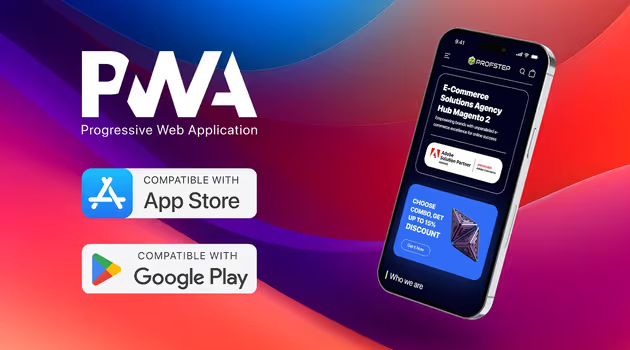So, as it was mentioned in our previous blog , we employed an innovative strategy and integrated the latest technology into our website. Specifically, we adopted PWA technology on our Magento (another name - Adobe Commerce) e-platform. But what exactly is PWA? We'll try to explain it as simply as possible.
What is a PWA in Simple Words?
A Progressive Web App (PWA) is an application developed using web platform technologies. Like regular websites, PWAs are hosted on servers and accessed through web addresses. However, what sets PWAs apart is their ability to be installed from a website onto any device, effectively functioning as standalone apps.
Now, you might be wondering: Are PWAs the same as apps on my phone? Not quite. While native apps are tailored to run specifically on mobile devices, PWAs are designed to operate within a web browser. Native apps are coded using platform-specific languages (such as Objective-C and Swift for iOS, and Java or Kotlin for Android), whereas PWAs utilize familiar web technologies like HTML, CSS, and JavaScript. The key distinction lies in the ease and speed of building and updating a PWA compared to native apps, making them a more cost-effective choice.
Moreover, PWAs have the advantage of being easily indexed and listed in search engines (such as Google or Bing), while native apps are typically discoverable only through app stores.
Besides, publishing an app on an app market isn't a simple task either. With a native app, you're required to develop separate versions for different platforms and submit them to various App Stores, meeting specific criteria for publication. This process often involves expenses, like registration fees for developer accounts. For example, on Apple’s App Store, fees range from $99 to $299. In contrast, with a PWA, all your users need is a web browser and a URL to download the website to their devices.
In the ever-evolving landscape of e-commerce, mobile commerce (or m-commerce) is rapidly emerging as the dominant force. It's projected that by the end of 2024, m-commerce sales will soar to an estimated $4.5 trillion, constituting nearly 70% of all retail e-commerce sales. Therefore, optimizing for mobile and providing a seamless experience across devices can significantly boost sales.
Furthermore, PWAs function differently from regular web pages. They offer enhanced performance and engagement, which can contribute to improved search engine rankings for your website. Based on tests and research, PWAs provide a better user experience and are more SEO-friendly compared to regular websites, making them a valuable asset for website marketing strategies.
Popular Questions
Are PWA apps safe?
While Progressive Web Apps may feel like a new technology, they are secure because they adhere to HTTPS protocols, just like any other website or web application.
Since they are accessed through web browsers, PWAs benefit from all the modern security features built into web browsers. However, developers should follow best practices in integrating HTTPS, utilizing service workers for offline support, sanitizing user input to prevent XSS attacks, employing strong authentication methods, being aware of data protection regulations like GDPR and CCPA, and establishing a robust Content Security Policy.
Therefore, for companies deciding to adopt PWAs, it's advisable to engage a developer team, that is certified in web development. This helps ensure the security of customer and company data and prevents any web attacks.
Can PWAs send push notifications?
Yes, indeed. PWAs can use push notifications to extend beyond the browser, enabling users to interact with your app without returning to your website. As a result, they can be effectively utilized by industries such as Media & Entertainment, E-commerce, Finance/Banking, Tourism, and others for marketing, sales strategies, and customer engagement purposes.
Which browsers support PWA?
PWAs are supported by various combinations of operating systems and web browsers. The Add to Home Screen functionality, which allows users to install PWAs to their Home Screen, Desktop, or Dock, is compatible with the following OS/Browser combinations:
- Windows with Chrome
- Windows with Edge
- Windows with Brave
- MacOS with Chrome
- MacOS with Edge
- Android with Chrome
- Android with Samsung Internet
- Android with Brave
- iOS with Safari
- iOS with Chrome (requires iOS 17 or higher)
- iOS with Edge (requires iOS 17 or higher)
- MacOS with Safari (requires Safari 17 or higher)
Can PWAs access the camera?
Yes, all modern Operating Systems provide access to the camera, enabling image and video capturing in PWAs. Additionally, PWAs can access other device features such as GPS, contact book, and calendar.
Can PWAs access the file system?
Yes, PWAs can access the native local file system, allowing users to read or save changes directly to files and folders on the device. This capability enables features such as file viewing, file editing, and drag-and-drop functionality. However, it's important to note that such access requires the user's permission to ensure security and privacy.
Can PWAs run in the background?
Yes, PWAs can run in the background, opening up numerous opportunities for implementing new and unique features. For actions that require a Wi-Fi connection, PWAs will pause and retry the action when the connection is restored. For example, if a user sends a message but there is no connection, the PWA will attempt to send it once the connection is available again. However, for actions that don't require an internet connection, such as listening to downloaded music or setting a timer and closing the app, there are no issues.
Can PWAs work offline?
Yes, PWAs can indeed run in offline mode. What's more, there's no requirement for users to install or add a PWA to the home screen to enable offline functionality. As long as assets are cached locally, both the website and app can work offline seamlessly.
Where does PWA store data?
Knowing how to manage your PWA's storage is crucial for storing and streaming network responses correctly. There are several methods through which a PWA can store data on a device, including local storage, the Cache API, and IndexedDB.
Will PWAs work on multiple platforms?
Like a website, a PWA can run on multiple platforms and devices from a single codebase. So, yes, PWAs will work on multiple platforms. As the saying goes, "Once built – works everywhere."
How to update PWAs?
Updating PWAs is a seamless process. When developers make changes to the PWA website, such as adding new text for example, the next time a user opens the app on their phone, the Service Worker will automatically fetch the necessary data from the website to the app. This means there is no need for users to worry about manually updating the app; it happens automatically in the background.
PWA with "near me" functionality?
"Near me" or Store Locator is one of the popular features. It utilizes the geolocation of the user to detect the nearest shop, for example. Or, when a user is near a shop, notifications can be sent to catch their attention and encourage them to visit the shop. Therefore, PWAs may have access to the phone’s GPS, making it possible to use such features effectively.
PWA with React?
Well, React, also known as React.js or ReactJS, is a free and open-source front-end JavaScript library. When using React in a PWA, we achieve an active Single Page Application (SPA) behavior. This means that when a user moves from one page to another, the website won't need to reload each time. As a result, we experience faster page load times and better overall performance.
Can PWAs be published in the App Store?
Well, before addressing this question, it's important to consider the target store. For instance, Google has a PWA-friendly app store due to its foundational role in PWA technology and active promotion. You can submit your app to Google Play, meet all the requirements, and publish it there.
However, the situation is different with Apple. In recent years, Apple has been blocking some PWA features to restrict their use among users. According to Apple’s App Store Review Guidelines, they believe PWAs don’t belong on the App Store. Despite this stance, there is hope for changes. For example, with iOS 15, Apple added more support for progressive web applications due to the wide use of PWAs. Furthermore, it's worth noting that Apple allows Safari to open and save PWAs to the home screen, enabling customers to access them just like other applications.
Regarding the Microsoft Store, PWAs are welcomed here. The company uses Bing to search for PWAs online and automatically adds them to its app store. Therefore, before submitting your app to the Microsoft Store, ensure it’s not already listed there. You can also submit your PWA manually to the store.
In conclusion, PWAs represent a powerful evolution in the world of digital technology. By harnessing the capabilities of web platform technologies, PWAs offer a seamless and cost-effective solution for businesses looking to expand their online presence and engage with customers across devices. Should you have any questions or wish to explore the potential of implementing a PWA for your company, feel free to contact us via email or social media.

